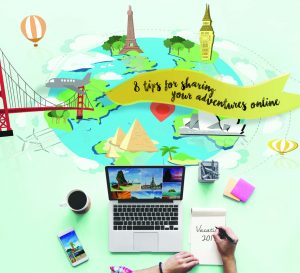The 8s
The Modern Vacation Slide Show: 8 tips for sharing your adventures online
December, 2016
Remember the seemingly endless slide shows your grandparents shared with family whenever they returned from their vacations? Thankfully, those days are gone. These days, it’s a lot easier and more entertaining to share your vacation adventures with friends, family—and even strangers—online. With a few simple tools and rules, you’ll be on your way to choosing the right platform and sharing the world as you see it. Here are 8 tips to get you started.
 1. Decide Why You’re Sharing
1. Decide Why You’re Sharing
Grandpa never intended to put everyone to sleep with his slides, but he did want to share his joy with you. Why do you want to share? Deciding will help determine what things to share (images, text, video), how often (daily, weekly) and how much (word count, video length, etc.). If medieval architecture is your passion, sharing pictures of old churches is probably appropriate. If your travel goal, however, is to share your perceptions of
Central American life, you’ll probably be better off writing about the people. Make a plan, and stick to it.
2. Know Your Audience
Who are you intending to share with? Family? Friends? Complete strangers? The Internet makes sharing with everyone easy, but you decide on your audience. If you’re posting just for friends, you can be more relaxed with your writing and editing. If, however, you want to appeal to a wider audience, consider a bit more care, and be aware of the dangers of oversharing. Remember, it’s almost impossible to delete anything once it’s online, and nothing is truly private. Always be circumspect about which details you put out there.
3. Choose a Platform
There are so many ways to share online (see sidebar). Some travellers like to blog during their trips, posting daily summaries so readers can follow along. Others prefer to share their special moments instantly on social media (Facebook, etc.) and let the audience knit together their own narrative. Video blogging (vlogging) is also popular and a great way to share “home movies.” Thanks to technology, creating a good-looking video is quite easy.
4. Know Your Timeline
Consider when you intend to post. Grandpa’s slideshow happened after the trip was over, but with social media, people can enjoy real-time updates. But that means you will likely just be sharing a short note or posting a quick picture. If you choose to write a more detailed blog or want to focus on vlogging, there will be a time gap before your audience enjoys it. Mixing real-time updates with a blog that is days or weeks behind can become quite confusing. Consistency is the key here.
5. Choose Your Tools
Travelling with a laptop can make some things easier, but isn’t the point of a vacation to get away from it all? However, with a little discipline, smartphones or tablets can be easy to use with the data functions turned off. And the cameras on newer phones are amazing at making it easy to post images. Of course, if photographs are your thing, a traditional camera is a must; just be aware that downloading and sharing those images will require more of your energy and your computer’s.
6. Make Notes
Even people with great memories need reminders. If you have a particularly poignant moment or learn something new and interesting, take a moment to jot it down. With the advent of smartphones, you can do this electronically, but also consider keeping an old-fashioned pen and notepad handy. Use the ubiquitous pile of brochures and tour maps to recall your day, too. Snapping a quick picture of a sign or location that you can erase later can also help keep your information organized.
7. A Picture Is Worth a Thousand Words
If you are writing a blog, rely on pictures to show the things that defy description. Don’t post multiple images that might look alike to your viewers; try taking images of interesting things that also have family or fellow travellers in them. That way you get the best of both worlds. Remember, too, that some pictures need captions; don’t assume people will know what they’re looking at.
8. Stay Connected
Figuring out how you’ll get online is worth a bit of forethought. Smartphones generally have some sort of worldwide data roaming, but often with hefty cost. Thankfully, if you avoid uploading lots of pictures, updates shouldn’t use much of your allotment. To avoid using precious data, keep on the lookout for Internet cafés. For smaller updates, free Wi-Fi can often be found in restaurants, hotels and shops. Remember, it’s worth being extra cautious when using someone else’s Internet; take care not to leave any logons or passwords on the system. t8n
Be Yourself!
Your voice is important. People will enjoy your adventure much more if you inject your personality into your shares. Make it about your unique perspective and you might meet people out there who like to see the world the way you do.
Platforms, Platforms, Everywhere Platforms
Looking for ways to share your adventure? You’ll find plenty.
Here are a few to get you started:
Blogs—generally more text based; open to everyone; will give you a domain like mytrip.blogspot.com or holidayinfrance.wordpress.org to share
blogspot.com, wordpress.com, tumblr.com
Vlogs—video-hosting sites; can be public or private
Check out Youtube.com, Vimeo.com
Social Media—generally require you to invite followers; can be public or private; simple image sharing, automatically resizes images for quick uploading
Check out facebook.com, twitter.com, instagram.com
Specialized Travel Sites—generally offer things like notifications, auto-mapping, help in planning your trip and sharing with like-minded travellers; free and paid versions
Check out travelpod.com, mytripjournal.com, travellerspoint.com, tripatlas.com
- audience
- blogs
- communication
- notes
- pictures
- sharing
- smartphones
- social media
- timeline
- travel sites
- vlogs
- website













